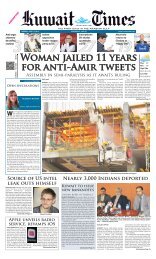ARAb StAtES diSMAyEd At WESt'S cOMPlAcENcy - Kuwait Times
ARAb StAtES diSMAyEd At WESt'S cOMPlAcENcy - Kuwait Times
ARAb StAtES diSMAyEd At WESt'S cOMPlAcENcy - Kuwait Times
You also want an ePaper? Increase the reach of your titles
YUMPU automatically turns print PDFs into web optimized ePapers that Google loves.
SATURDAY, MAY 4, 2013<br />
BOSTON: Carmen Blandin Tarleton, of Thetford,<br />
Vermont, speaks with reporters at Brigham and<br />
Women’s Hospital in Boston.— AP<br />
US woman disfigured in<br />
attack reveals new face<br />
BOSTON: A Vermont woman has revealed her new face, six<br />
years after her ex-husband disfigured her by dousing her<br />
with industrial-strength lye, and said she went through “what<br />
some may call hell” but has found a way to be happy. Carmen<br />
Blandin Tarleton of Thetford had face transplant surgery at<br />
Boston’s Brigham and Women’s Hospital in February and<br />
spoke publicly for the first time at a news conference at the<br />
hospital Wednesday. “I’m now in a better place, mentally and<br />
emotionally, than I ever could have imagined six years ago,”<br />
said Tarleton, a former transplant nurse. “I want to share my<br />
experience with others, so they may find that strength inside<br />
themselves to escape their own pain.” In 2007, the 44-yearold<br />
mother of two was attacked by her then-husband,<br />
Herbert Rodgers, who believed she was seeing another man.<br />
Police say he went to the house looking for that man, then<br />
went into a fury directed toward Tarleton, striking her with a<br />
bat and pouring lye from a squeeze bottle onto her face.<br />
When police arrived, Tarleton was trying to crawl to a<br />
shower to wash away the chemical. It already had distorted<br />
her face. In 2009, Rodgers pleaded guilty to maiming Tarleton<br />
in exchange for a prison sentence of at least 30 years. “I<br />
learned that ... forgiveness doesn’t condone anything he did<br />
and it’s not about him - it’s about forgiving him, it’s forgiving<br />
myself, it’s allowing myself to move forward and not getting<br />
stuck in the tragedy of that night,” said Tarleton, who has<br />
undergone 55 surgeries during the past five years.<br />
During the face transplant surgery, more than 30 surgeons,<br />
anesthesiologists and nurses worked for more than 15<br />
hours to replace her skin, muscles, tendons and nerves, the<br />
hospital said. The face donor was a Williamstown, Mass.,<br />
woman named Cheryl Denelli Righter who died of a sudden<br />
stroke, a hospital spokeswoman said. Righter’s daughter,<br />
Marinda, told Tarleton on Wednesday that she looked beautiful,<br />
adding she was certain her mother had somehow picked<br />
Tarleton. —AP<br />
LONDON: Is nanomedicine the next big<br />
thing? A growing number of top drug companies<br />
seem to think so. The ability to<br />
encapsulate potent drugs in tiny particles<br />
measuring billionths of a meter in diameter<br />
is opening up new options for super-accurate<br />
drug delivery, increasing precision hits<br />
at the site of disease with, hopefully, fewer<br />
side effects. Three deals struck this year by<br />
privately held Bind Therapeutics, together<br />
worth nearly $1 billion if experiments are<br />
successful, highlight a new interest in using<br />
such tiny carriers to deliver drug payloads<br />
to specific locations in the body.<br />
US-based Bind is one of several biotechnology<br />
firms that are luring large pharmaceutical<br />
makers with a range of smart drug<br />
nanotechnologies, notably against cancer.<br />
And nanomedicine is also being put to<br />
work in diagnosis, with tiny particles used<br />
to improve imaging in scanners, as well as<br />
rapidly detecting some serious infections.<br />
In future, researchers hope to combine<br />
both treatment and diagnostics in a new<br />
approach dubbed “theranostics” that<br />
would allow doctors to monitor patients via<br />
their medicines.<br />
After much hype but limited clinical success,<br />
scientists in the nanotechnology field<br />
finally see a turning point. “We have been<br />
hearing about the promise of nanomedicine<br />
for a long time, but it is now really<br />
starting to move,” said Dan Peer, who runs<br />
a nanomedicine laboratory at Tel Aviv<br />
University. “There is a new level of confidence<br />
in this approach among the big<br />
pharmaceutical companies ... We will see<br />
more and more products in clinical testing<br />
over the next few years and I think that is<br />
very exciting.”<br />
Nanoparticles made of polymers, gold<br />
and even graphene - a newly-discovered<br />
form of carbon - are now in various stages<br />
of development. In cancer alone, 117 drugs<br />
are being assessed using nanoparticle formulations,<br />
though most have yet to be<br />
tried on patients, according to Thomson<br />
Reuters Pharma data. Other potential applications<br />
include treatments for inflammatory<br />
disorders, heart and brain diseases, and<br />
pain.<br />
COLLATERAL DAMAGE<br />
Companies are increasingly focused on<br />
better drug targeting to increase efficacy<br />
and lessen the collateral damage caused by<br />
medicinal “carpet bombing” - a particular<br />
problem in cancer, where toxic compounds<br />
are needed to kill tumors. The work on<br />
drug-carrying nanoparticles parallels<br />
advances in using so-called “armed antibodies”<br />
to deliver drugs direct to cancer<br />
cells - an approach championed by Roche.<br />
The Swiss group won US approval in<br />
February for Kadcyla, its first such antibodydrug<br />
conjugate, which treats breast cancer<br />
with fewer side effects like hair loss.<br />
“All these developments have prompted<br />
companies to look at new avenues<br />
because the older ways of using drugs<br />
haven’t worked so well,” said Robert<br />
Langer, a pioneer of nanomedicine who<br />
runs the world’s largest biomedical engineering<br />
laboratory at the Massachusetts<br />
Institute of Technology. Having worked on<br />
drug delivery since the 1970s, Langer has<br />
seen plenty of ups and downs. The world’s<br />
first nanomedicine was actually approved<br />
back in 1995 when US regulators gave a<br />
green light to Doxil for treating Kaposi’s sarcoma,<br />
a cancer often associated with AIDS.<br />
Doxil - a hollow fatty ball known as a<br />
liposome with a cancer-killing drug inside it<br />
- was a breakthrough. Yet few other<br />
nanomedicines have followed. Recent scientific<br />
advances have changed the game,<br />
however. Bind’s nanoparticles, for example,<br />
are programmed to reach the right<br />
spot using targeting molecules that recognize<br />
specific proteins linked to disease on<br />
the surface of cells. They also have a stealth<br />
covering that shields them from the<br />
immune system, in order to minimize<br />
adverse reactions.<br />
Since January, Amgen, Pfizer and<br />
AstraZeneca have all signed up to use<br />
Bind’s technology, which comes from work<br />
originally carried out in Langer’s lab. And<br />
Bind is not the only game in town. Another<br />
approach, using tiny particles of gold as<br />
health<br />
Big drugmakers think small<br />
with nanomedicine deals<br />
Nanomedicine promises<br />
greater precision and monitoring<br />
drug carriers, is being explored in a deal<br />
that AstraZeneca signed in December with<br />
CytImmune. “Anything you can do to<br />
improve targeting of tumors rather than<br />
normal tissue - whether that is through an<br />
armed antibody or nanoparticle approach -<br />
increases the chance of success,” said Susan<br />
Galbraith, who leads AstraZeneca’s oncology<br />
research.<br />
PARALLEL APPROACHES<br />
The work remains early stage and Peer<br />
of Tel Aviv University says all the novel carriers<br />
will have to be studied closely for<br />
potential toxicity. However, experience<br />
with liposomes is good and versions of<br />
gold nanoparticles have also been used<br />
safely for many years to treat rheumatoid<br />
arthritis. Injecting patients with gold may<br />
sound like a pricey option but with thousands<br />
of nanoparticles fitting into the width<br />
of a human hair, the amount of metal used<br />
is tiny. Gold, unlike some other metals, is<br />
not toxic and has been used in various<br />
medical treatments for many years without<br />
harmful effects. Bind CEO Scott Minick also<br />
thinks his polymer technology will have<br />
cost advantages over expensive antibody<br />
drugs.<br />
Further out, Kostas Kostarelos, professor<br />
of nanomedicine at University College<br />
London, has high hopes for graphene - a<br />
one-atom-thick form of carbon. His team is<br />
currently working with graphene nanomaterials<br />
in pre-clinical experiments. “We will<br />
see parallel development of different materials,<br />
each offering something different<br />
therapeutically,” he said. Other venturebacked<br />
nanomedicine firms include<br />
Cerulean Pharma, whose technology has<br />
made a highly potent cancer drug tolerable<br />
but which recently had disappointing<br />
results in a clinical study, and two companies<br />
looking at new vaccines.<br />
Selecta Biosciences has a deal on food<br />
allergy vaccines with Sanofi, while Liquidia<br />
Technologies is allied with GlaxoSmithKline<br />
on vaccines and inhaled products. MIT’s<br />
Langer is convinced more Big Pharma companies<br />
will think small in future. —Reuters<br />
Fears for man-made bird flu bug<br />
PARIS: Immunologists expressed concern<br />
yesterday about the “dangerous” work of<br />
scientists in China who created a hybrid<br />
bird flu virus that can spread in the air<br />
between guinea pigs, and now lives in a<br />
lab freezer. The team from the Chinese<br />
Academy of Agricultural Sciences and<br />
Gansu Agricultural University wrote in the<br />
journal Science they had created a new<br />
virus by mixing genes from H5N1 “bird flu”<br />
and H1N1 “swine flu”. H5N1, transmitted to<br />
people by birds, is fatal in about 60 percent<br />
of cases, but does not transmit between<br />
humans-a characteristic that has prevented<br />
a pandemic so far.<br />
Some argue that hybrid studies like<br />
these shed light on how the virus could<br />
mutate in nature to cause a human epidemic,<br />
and may help us prepare. Since<br />
2003, H5N1 has infected 628 people, killing<br />
374, according to the World Health<br />
Organization. H1N1, which erupted in<br />
Mexico, is highly transmissible and infected<br />
a fifth of the world’s population in a<br />
2009-10 pandemic, but is about as lethal as<br />
ordinary flu. The new mutant virus was<br />
easily transmitted between guinea pigs<br />
through respiratory droplets-which the<br />
Chinese team said proved the deadly H5N1<br />
virus may need but a simple genetic mutation<br />
to “acquire mammalian transmissibility”.<br />
Flu hybrids can arise in nature when<br />
two virus strains infect the same cell and<br />
exchange genes in a process known as<br />
reassortment, but there is no evidence that<br />
H1N1 and H5N1 have done so yet. Some<br />
observers fear that science is putting<br />
mankind at risk by preemptively creating<br />
such mutants. “These are manmade viruses,<br />
they have never been made in Nature.<br />
They are now sitting in a freezer,” virology<br />
professor Simon Wain-Hobson of France’s<br />
Pasteur Institute said.<br />
He pointed to a laboratory leak of foot<br />
and mouth, a cattle disease, which caused<br />
an outbreak in Britain six years ago. It was<br />
unclear how the flu hybrid, which is not<br />
deadly in guinea pigs, would affect peoplebut<br />
Wain-Hobson warned: “These could be<br />
pandemic viruses. “That is, if there was<br />
ever an error of they got out or there was a<br />
leak or whatever, this could infect people<br />
and cause anywhere between 100,000 and<br />
100 million deaths.” Wain-Hobson and others<br />
fear the risk may far outweight the scientific<br />
value of the research. The findings<br />
held little value for finding a vaccine or<br />
treatment that would take years to develop-probably<br />
long after an outbreak, they<br />
argue.<br />
“The record of containment in the highest<br />
containment laboratories is not good.<br />
There have been repeated leaks,” said<br />
Robert May, a former president of Britain’s<br />
Royal Society of science. “You do not do<br />
these things unless there is some call of<br />
extreme emergency,” he said. “We are<br />
encountering a real and present danger<br />
with extremely dubious benefits to the<br />
public.” Virologist John Oxford from the<br />
Queen Mary University of London, however,<br />
said the experiment was a valuable<br />
wakeup call. It showed that the two viruses,<br />
both still infecting people around the<br />
world, can swap genes.<br />
“Mathematics will tell you that sooner<br />
or later a person will get co-infected,” he<br />
said-possibly leading to a hybrid virus “that<br />
will start spreading”. “We need to get ourselves<br />
reorganizes, relook our pandemic<br />
plans and make sure we have H5N1 vaccine<br />
stockpiles,” Oxford said. In January,<br />
scientists in the United States and the<br />
Netherlands resumed controversial<br />
research into their own hybrid flu viruses<br />
after taking a year-long break to allay fears<br />
of the bug escaping the lab or falling into<br />
terrorist hands.— AFP
















